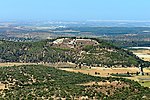Battle of Ajnadayn
630s conflicts630s in the Byzantine Empire634Battles involving the Byzantine EmpireBattles of Abu Ubaidah ibn al-Jarrah ... and 5 more
Battles of Khalid ibn WalidBattles of the Arab–Byzantine warsMedieval PalestineMuslim conquest of the LevantValley of Elah

The Battle of Ajnadayn (Arabic: معركة أجنادين) was fought in July or August 634 (Jumada I or II, 13 AH), in a location close to Beit Guvrin in the present-day Palestine region; it was the first major pitched battle between the Byzantine (Roman) Empire and the army of the Arab Rashidun Caliphate. The result of the battle was a decisive Muslim victory. The details of this battle are mostly known through Muslim sources, such as the ninth-century historian al-Waqidi.
Excerpt from the Wikipedia article Battle of Ajnadayn (License: CC BY-SA 3.0, Authors, Images).Battle of Ajnadayn
Mate Yehuda Regional Council
Geographical coordinates (GPS) Address Nearby Places Show on map
Geographical coordinates (GPS)
| Latitude | Longitude |
|---|---|
| N 31.683333333333 ° | E 34.95 ° |
Address
9920828 Mate Yehuda Regional Council
Jerusalem District, Israel
Open on Google Maps











